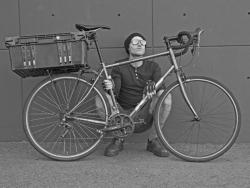How SF Bike Messengers Do It
Besides cups of coffee, there are plenty of other things I don’t deliver. Pizzas, mixed drinks, furniture, soup, birthday cakes. Basically anything too large or too fragile to throw in a produce crate and strap down with a spent inner tube. Smaller, jostle-proof items are preferable. Salads, sandwiches, cough syrup, beer, wine, cigarettes, roast ducks, printer toner, donuts. All these I’ve shipped because they’re smaller than a footlocker and can be shaken around. Electronics, ipads, sneakers, lobstertails, guitar strings. Before each order I have to ask myself, would I feel comfortable sealing this in a ziploc bag and sending it down the raging Zambezi? If the answer is yes, then it goes in the crate.
After that, I look at distance. If it’s the first delivery of the day, I’ll take a three mile trip. Anything thereafter I prefer to be around two or less. That doesn’t sound like much, but I like to keep my wind and do shorter jobs and more of them. Besides which, though I ride a bike, most of the couriers out there drive. Let them take the five mile jobs. And being paid by the job and not the hour, it doesn’t do me any good to pick up a delivery to the Richmond or Presidio when once I’m out there I won’t be able to snag another. At that point I’ll just have to pedal back to FiDi, SoMa, or at least North Beach or the Marina. Unpaid, and therefore wasted time.

Nob Hill, San Francisco (Looking west up California Street, Nob Hill district, San Francisco) – Photo by Dave Glass (flickr.com/daveglass)
Next I have to consider payout. The mystic algorithm in charge of sorting and assigning orders determines price based off only two factors: distance and demand. As each goes up, so does the price. The expense, fragility, or cumbersome nature of the item has nothing to do with it. Which is why an order for a macbook pro and a cornerstore bagel could be priced as the same payout, and the question I have to ask instead is would I rather fight the doughy bros of the Apple store, or the construction workers on line at the bagel shop? Nearly always I’ll pick the Apple store.
The final consideration is the most elusive to judge acurately, and that’s how likely is the customer to tip. Everything else has by this point been measured, so this last consideration is complete guess work. For catch-all delivery services like this one, customers have a way to tip through the app, and tip is calculated based off percentage. A fifteen percent tip on a seven hundred dollar Apple order is attractive indeed. So now you might understand while I’ll almost always go for that macbook delivery, and further clue you in to why coffee is not worth my time, not just because it’s easier to intimidate Apple store clerks than baristas.
So the most basic tip-off to a good tipper is the nature of the item itself. High end electronics especially. The next clue is the location. An order for twenty bottles of wine on a Friday afternoon to an office high rise in FiDi? My biker sense says office party, good feeling for the weekend, and the company card. I don’t even hesitate. People almost never seem to mind tipping the delivery guy when it’s the company on the hook. But a single Mission burrito up Pacific Heights? Go die in a fire.
Now I understand tipping is a bizarre practice. I don’t think I’ve ever tipped a mailman or a UPS driver. We both work deliveries, so why don’t I leave a little something in the mailbox? Because they work for companies that offer health benefits, dental insurance, and 401ks. They’ve got the protective shell of a motor vehicle around them to isolate them from collisions and weather. The hardest they’ll have to work to get up 17th Street’s 23% grade is to flex the tendons in their right ankles. I don’t get any of that. My company offers no benefits. I’m not encapsulated in some metal husk. When it rains I get wet. Without tips I average $8.50 an hour. I could make more picking fruit. My retirement plan is facefirst into an oncoming Fedex truck and dead before I hit the payment.
Of course, it’s not a foolproof system. Given all these considerations it’s still possible to misjudge. I had one time I accepted a pickup for a $900 amplifier to be delivered from Castro to SoMa, and had it explained all the way how important it was that I take precautions to transport the device safely. Got the address on Howard and been told flatly by the client that he wasn’t going to tip, even though I had not asked.
“If you want to make money, then find another job,” he said.
As though I had taken the position because of a deep spiritual commitment to quality parcel delivery.

Even if you’re only passingly acquainted with San Francisco you’ll notice I’ve left something out, but hills almost never enter my consideration. There’s quite a number of customers I’d be turning down if I refused, and once I’m up by Grace Cathedral or Coit Tower, I get to enjoy some of the lovelier views of the bay. I like figuring out the challenge of getting around and through, and occasionally up to their summits. The hills are the principal reason to feel proud – alright, smug – about my work. To know that I earned my way up here.
Cover Photo: Josephine Reitzel (bicycling.com)











